TRIP REPORT: OHIO & MICHIGAN – 2013 May – Magee Marsh & Kirtland’s Warbler

TOUR FOCUS
TRIP LEADERS
PRIVATE TOUR OPTION
This tour is available as a private trip for any size group. The tour cost will vary with the number of people and any custom requests.
TESTIMONIALS
Trip report by Adrian Binns
 Our May 2013 trip to the “Warbler Capital of the World” lived up to its name, as the shores of Lake Erie in the Northwestern region of Ohio remains one of the best places in North America to witness the spectacle of spring migration.
Our May 2013 trip to the “Warbler Capital of the World” lived up to its name, as the shores of Lake Erie in the Northwestern region of Ohio remains one of the best places in North America to witness the spectacle of spring migration.
Our experience centered largely on Magee Marsh, with visits to nearby Metzger Marsh and Ottawa National Wildlife Refuge, as well as Maumee Bay State Park and Oak Openings in Toledo. Our trip concluded with an overnight stay in northern Michigan to see Kirtlandʼs Warbler in its breeding habitat.
 We spent the most time at the 7-mile remnant beach habitat of Magee Marsh, meandering along the boardwalk through deciduous woods dominated by canopy Eastern Cottonwoods and Hackberry trees. On cool mornings, we started at the edge of the woods where the first places to be warmed by the sun attracted hungry birds. We were delighted with the number of birds flitting low and close, so that even point-and-shoot photographers had to step back to get one in focus!
We spent the most time at the 7-mile remnant beach habitat of Magee Marsh, meandering along the boardwalk through deciduous woods dominated by canopy Eastern Cottonwoods and Hackberry trees. On cool mornings, we started at the edge of the woods where the first places to be warmed by the sun attracted hungry birds. We were delighted with the number of birds flitting low and close, so that even point-and-shoot photographers had to step back to get one in focus!
Mornings warmed quickly and Mageeʼs famed boardwalk was soon filled with birders and photographers of all ages and experiences. Fortunately there was plenty of activity for all to enjoy along the one-mile stretch. Blackburnian, Magnolia, Black-throated Green, Yellow and Yellow-rumped Warblers were the most numerous, with several dozen of each.
We enjoyed seeing American Redstart, Ovenbird, Northern Parula, and Mourning , Wilsonʼs, Chestnut-sided, Bay-breasted, Black-throated Blue, Nashville, Palm, Black-and-white, Common Yellowthroat, Prothonotary Warblers, Northern and Louisiana Waterthrushes, the latter being a surprise at such a late date. By the end of our first full day, we had logged 20 warbler species.
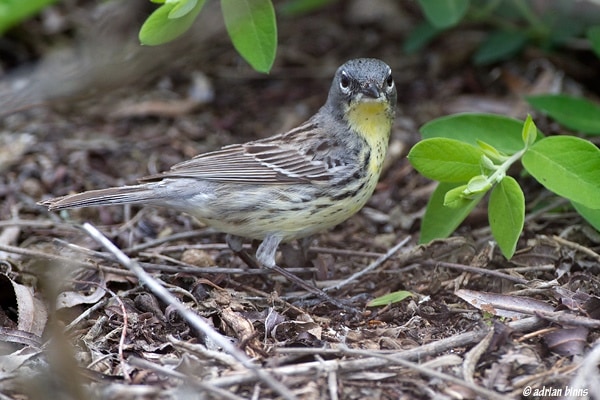
Kirtlandʼs Warbler

Mourning Warbler
We were thrilled to see a female Kirtlandʼs Warbler (above) on our second day at Magee Marsh, hurrying to the East Beach after a full morning at Oak Openings. By Day 4, a shift in weather brought an exciting change in activity on the boardwalk. Flocks of Cedar Waxwings roved over the treetops, while Blackpoll, Cape May and Canada Warblers were added to our list. Normally-elusive Mourning Warblers (right) showed extremely well, while sightings of a male Hooded Warbler were fleeting.
If myriad warblers at close range were not enough, we enjoyed a variety of other passerines over several days exploring around Magee Marsh. Wood Thrush (below), Veery, Swainsonʼs and Gray-cheeked Thrushes skulked in the understory. Lincolnʼs and White-crowned Sparrows joined numerous White-throats in scratching leaf-litter. An American Woodcock was found on her nest in the parking lot, well-camouflaged but enjoyed by many visitors, along with a sighting of at least one each day within the woods. Warbling Vireos were abundant and there were a handful of Red-eyed, one of which we watch feeding low in a bush.
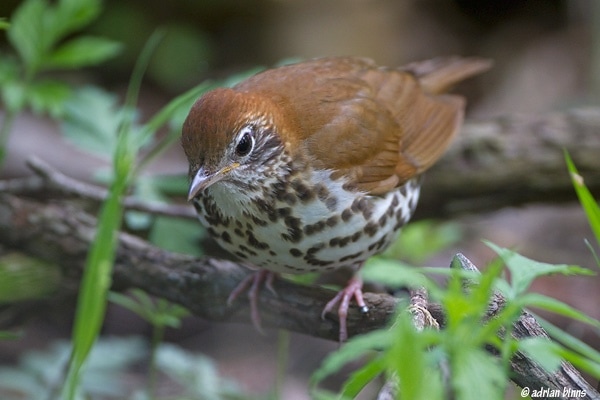
Wood Thrush
We greatly enjoyed seeing a fledgling Great Horned Owl that was branching out over the trail. Among the flashiest birds were Baltimore Oriole, Scarlet Tanager, Rose-breasted Grosbeak and “Yellow-shafted” Northern Flicker calling from its nest hole. Flycatchers included good looks at an Olive-sided and a calling Alder, to go along with the more common Willow, Least and Great-crested, Eastern Wood-Pewee, Eastern Phoebe and animated Eastern Kingbirds. A Sora stalked over fallen branches, and several Black-billed Cuckoos grew quite a crowd of onlookers eager for a glimpse of this often elusive species.
 A Common Nighthawk was spotted by sharp eyes, nearly invisible on its daytime roost near the top of cottonwood. Trumpeter Swans were seen each time we drove into Magee Marsh, admired as they swam alongside the causeway. At the end of the Estuary Trail (left), mudflats held hundreds of Dunlin, and a lone Short-billed Dowitcher. Caspian, Common and Forsterʼs Terns swooped and soared, amongst a single Bonaparteʼs Gull and the expected Ring-billed and Herring Gulls. Also near the entrance to the trail, we watched a female Hooded Merganser fly into a tree, perhaps inspecting a potential cavity.
A Common Nighthawk was spotted by sharp eyes, nearly invisible on its daytime roost near the top of cottonwood. Trumpeter Swans were seen each time we drove into Magee Marsh, admired as they swam alongside the causeway. At the end of the Estuary Trail (left), mudflats held hundreds of Dunlin, and a lone Short-billed Dowitcher. Caspian, Common and Forsterʼs Terns swooped and soared, amongst a single Bonaparteʼs Gull and the expected Ring-billed and Herring Gulls. Also near the entrance to the trail, we watched a female Hooded Merganser fly into a tree, perhaps inspecting a potential cavity.
 We spent a delightful morning at Oak Openings Preserve (right), a 3,700-acre park featuring a unique and diverse habitat in western Toledo. Soon after arriving, I got word that a Kirtlandʼs Warbler had been found back at Magee. We gambled that the bird would stay there while we continued with our plan to bird Oak Openings for the morning! We were not disappointed, with wonderful looks of Eastern Meadowlarks, Eastern Kingbirds, Baltimore and Orchard Orioles, Indigo Buntings, Eastern Bluebirds and two nice male Summer Tanagers (below). Shrubby areas held Blue-winged Warbler and White-eyed Vireo, while short grass fields buzzed with Grasshopper, Savannah, and Field Sparrows. There is an isolated colony of Lark Sparrows that breeds along the sand ridge that bisects the preserve, and we soon found a handful of them feeding along roadside verges.
We spent a delightful morning at Oak Openings Preserve (right), a 3,700-acre park featuring a unique and diverse habitat in western Toledo. Soon after arriving, I got word that a Kirtlandʼs Warbler had been found back at Magee. We gambled that the bird would stay there while we continued with our plan to bird Oak Openings for the morning! We were not disappointed, with wonderful looks of Eastern Meadowlarks, Eastern Kingbirds, Baltimore and Orchard Orioles, Indigo Buntings, Eastern Bluebirds and two nice male Summer Tanagers (below). Shrubby areas held Blue-winged Warbler and White-eyed Vireo, while short grass fields buzzed with Grasshopper, Savannah, and Field Sparrows. There is an isolated colony of Lark Sparrows that breeds along the sand ridge that bisects the preserve, and we soon found a handful of them feeding along roadside verges.

Summer Tanager

Red-headed Woodpecker
We enjoyed watching resident Red-headed Woodpeckers (right) including a first-spring immature (black patches and spots within the white secondaries) flashing through the trees, and, while watching a bluebird, we were pleasantly surprised when an Olive-sided Flycatcher flew into view, devoured a bug on a branch, then flew off! Several birds we would have enjoyed seeing but only heard were Hooded Warbler and a Pileated Woodpecker drumming within the oak woods.
At a feeder station outside the new “Window on Wildlife” wing of the Oak Openings nature center, an assortment of eastern feeder birds were jostling for space and consuming seed. Pine Siskins, Chipping Sparrows, Blue Jays, Red-breasted Nuthatch, Northern Cardinal, Downy Woodpecker, and American Goldfinches, along with the antics of Red Squirrel and Eastern Chipmunk, held our attention for a long while, before we pulled ourselves away for a delicious lunch of Greek gyros and kebabs.

Canada Warbler
On a side trip to Metzger Marsh we saw a raft of American Coot and seven Bald Eagles standing on a distant mudflat as well as a Black-billed Cuckoo seen flying along the dike road. The small woodlot on the northern end of the area was the main attraction, highlighting 13 species of warblers in one and a half hours including a lovely Canada Warbler (left). Sadly we could not locate the reported Golden-winged, however we did find our first Eastern Whip-poor-will perched in a Cottonwood tree and well concealed by leaves.

Eastern Screech Owl
Our visit to Maumee Bay, a large state park with swimming and recreational facilities, was relatively quiet except for a small mixed flock of warblers near the beginning of the nature trail. There was great excitement when we spotted a fluffy juvenile Eastern Screech Owl (right) peeking out of a nest box. We soon located an adult sleeping in a nearby tree and to our surprise watched its mate fly into the box. It seemed to me that it did not want the youngster looking out at us, as it soon appeared at the entrance glaring at us! On the beach, we observed a group of loafing Ring-billed Gulls and Forsterʼs Terns, as well as a Least Sandpiper and two Dunlins. After dinner at the lodge, we relaxed in comfortable sofas waiting for the sunset show to begin, when American Woodcocks should begin their acrobatic displays. Alas, there was just one Common Nighthawk flying low, one calling Eastern Whip-poor-will, and a single peent of a woodcock.
 Driving along picturesque rural roads, we saw Horned Larks foraging with Killdeer in plowed fields, and found a flock of American Pipits at the Boss Unit (below). It was also here, amongst the flooded field of this property managed by Ottawa National Wildlife Refuge specifically for waterfowl and shorebirds, that we saw Blue-winged Teal, Dunlin, Lesser Yellowlegs, Least Sandpiper, Semipalmated Plover and Spotted Sandpiper. On a private farm property managed especially for grassland species, we watched Bobolinks displaying and Grasshopper Sparrows singing. On the narrow beach at Camp Perry a handful of shorebirds included Dunlin, Sanderling, Spotted Sandpiper and a “Western” Willet.
Driving along picturesque rural roads, we saw Horned Larks foraging with Killdeer in plowed fields, and found a flock of American Pipits at the Boss Unit (below). It was also here, amongst the flooded field of this property managed by Ottawa National Wildlife Refuge specifically for waterfowl and shorebirds, that we saw Blue-winged Teal, Dunlin, Lesser Yellowlegs, Least Sandpiper, Semipalmated Plover and Spotted Sandpiper. On a private farm property managed especially for grassland species, we watched Bobolinks displaying and Grasshopper Sparrows singing. On the narrow beach at Camp Perry a handful of shorebirds included Dunlin, Sanderling, Spotted Sandpiper and a “Western” Willet.
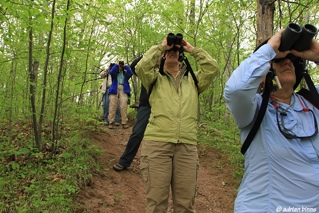
We departed early on May 17 for the drive north to Michigan. We made a late-morning stop at the Pine Haven Recreational area to walk lovely trails through mixed deciduous forest. We enjoyed seeing and hearing Wood Thrush, Rose-breasted Grosbeak, Scarlet Tanager, Yellow-bellied Sapsucker, Red-eyed Vireo, Blue-headed Vireo, Eastern Wood Pewee, Brown Creeper, American Redstarts, Pine Warblers, and a pair of our target Cerulean Warblers, one of which approached us just above head height as we waited on a slope.

At Houghton Flats we were enthralled to watch a pair of Osprey dive-bombing an immature Bald Eagle until the eagle finally moved far enough away from the Ospreyʼs nest. We found Blue-winged Teal and Sandhill Cranes here too but the high water levels meant that the hoped for Black Terns did not have any loafing area.
Reaching Grayling, we made our final stop of the day at Hartwick Pines State Park, highlighting an expansive old-growth forest of mature beech, maple and hemlock trees. At the Visitors Center feeding station we watched Evening and Rose-breasted Grosbeaks taking sunflower seeds as the black morph of Eastern Fox Squirrel, Eastern Chipmunk and Red Squirrels scampered around the ground and trees.

Rose-breasted Grosbeak
Walking the Old Forest loop, we heard a Barred Owl hooting “Who Cooks for You,” and found a nice assortment of late-afternoon warblers, including Black-throated Green, Ovenbird, American Redstart, Blackburnian, Yellow-rumped and trilling Pine Warblers. We heard Red-breasted Nuthatch, Brown Creeper and Hairy Woodpecker.
 Our final day of the trip began with a 15-minute video presentation at our hotel about the Kirtlandʼs Warbler and its habitat. It outlined the forty-year management plan that has brought the Kirtlandʼs Warbler from the brink of extinction with 200 singing males in 1970, to the current population of about 2,000 pairs. Habitat restoration and control of cowbirds are the main factors to the success. Kirtlandʼs breed specifically in Jack Pine trees that are 3-8 feet in height, with their outer boughs touching the ground.
Our final day of the trip began with a 15-minute video presentation at our hotel about the Kirtlandʼs Warbler and its habitat. It outlined the forty-year management plan that has brought the Kirtlandʼs Warbler from the brink of extinction with 200 singing males in 1970, to the current population of about 2,000 pairs. Habitat restoration and control of cowbirds are the main factors to the success. Kirtlandʼs breed specifically in Jack Pine trees that are 3-8 feet in height, with their outer boughs touching the ground.
 A group of 28 people followed the friendly Forest Service staff by car 10 miles east of Grayling to a large stand of young Jack Pine trees. On the way, we encountered a dozen Wild Turkeys with several toms displaying.
A group of 28 people followed the friendly Forest Service staff by car 10 miles east of Grayling to a large stand of young Jack Pine trees. On the way, we encountered a dozen Wild Turkeys with several toms displaying.
Under dreary skies and a light drizzle there was no shortage of Kirtlandʼs singing, however getting a view of one proved tougher. There was a distant male in a deciduous tree that we got in the scope and another briefly seen a little closer before it dropped out of sight. We were unable to get better views, though we could hear them singing very close to us, and glimpse them fleetingly as they zipped low from one pine to another, staking out their territories. The preserved habitat also held Clay-colored, Field and Lincolnʼs Sparrow, Nashville Warbler, Brown Thrasher, Eastern Towhee and Upland Sandpiper.
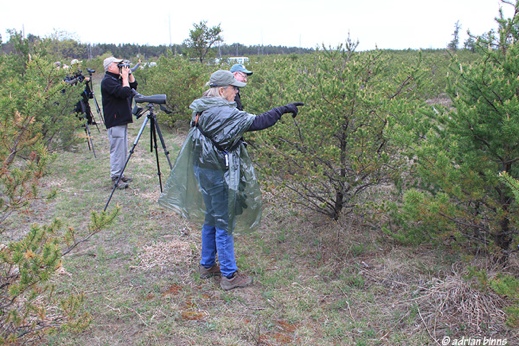
We packed up and began our journey south, stopping briefly for a hearty lunch at a pizzeria in West Branch. Several pullovers produced Savannah Sparrow and many Bobolinks before reaching our final destination the airport in Detroit.
Our trip ended with 30 warblers among a total of 166 species. We also logged 2 amphibian, 4 reptile, 3 dragonfly, 9 butterfly and 12 mammal species. Many thanks to all the trip participants who made this trip to the Warbler Capital of the World truly wonderful!
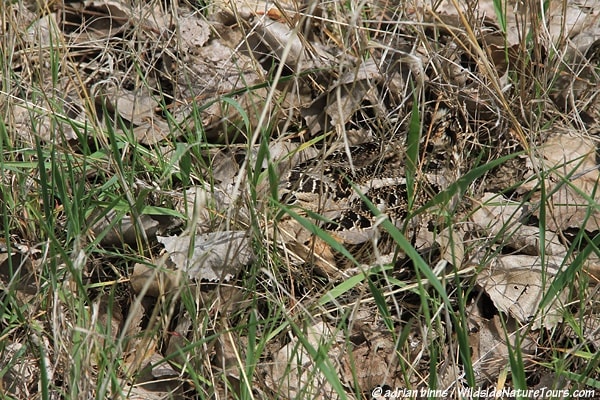
Somewhere in there is a very well camouflaged American Woodcock sitting on her nest!



